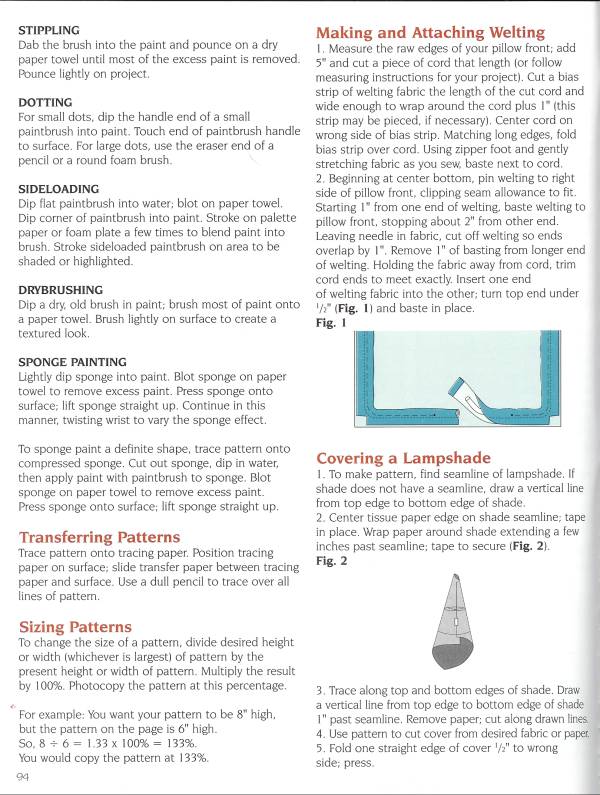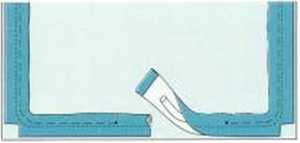94 (14)


STIPPLING
Dab the brush into the paint and pounce on a dry paper towel until most of the excess paint is removed. tounce lightly on project.
DOTTING
For smali dots. dip the handle end of a smali paintbrush into paint. Touch end of paintbrush handle to surface. For large dots, use the eraser end of a pencil or a round foam brush
SIDELOADING
Dip fiat paintbrush into water; biot on paper towel.
Dip comer of paintbrush into paint. Stroke on palette paper or foam piąte a few times to blend paint into brush. Stroke sideloaded paintbrush on area to be shaded or highlighted.
DRYBRUSHING
Dip a dry, old brush in paint; brush most of paint onto a paper towel. Brush lightly on surface to create a textured look.
SPONGE PAINTING
Lightly dip sponge into paint. Biot sponge on paper towel to remove excess paint. Press sponge onto surface; lift sponge straight up. Continue in this manner, twisting wrist to vary the sponge effect.
To sponge paint a definite shape. tracę paltem onto compressed sponge. Cut out sponge, dip in water, then apply paint with paintbrush to sponge. Biot sponge on paper towel to remove excess paint.
Press sponge onto surface; lift sponge straight up.
Transferring Patterns
Tracę pattern onto tracing paper. Position tracing paper on surface; slide transfer paper between tracing paper and surface. Use a duli pencil to tracę over all lines of pattem.
Sizing Patterns
To change the slze of a pattern, divide desired height or width (whichever is largest) of pattem by the present height or width of pattem. Multiply the result by 100%. Photocopy the pattem at this percentage.
For example: You want your pattem to be 8" high. but the pattem on the page is 6" high.
So. 8 6 = 1.33 x 100%= 133%.
You would copy the pattem at 133%.
Making and Attaching Welting
I. Measure the raw edges of your pillow front; add 5’ and cut a piece of cord that length (or follow measuring instructions for your project). Cut a bias strip of welting fabric the length of the cut cord and wide enough to wrap around the cord plus 1“ (this strip may be pieced. if necessary). Center cord on wrong side of bias strip. Matching long edges, fold bias strip over cord. Using zipper foot and gently stretching fabric as you sew. baste next to cord 2 Beginning at center bottom, pin welting to right side of pillow front, clipping seam allowance to fi:. Starting I" from one end of welting, baste welting to pillow front, stopping about 2” from other end. Leaving needle in fabric, cut off welting so ends overlap by I". Remove I" of basting from longer end of welting. Holding the fabric away from cord, trim cord ends to meet exactly. Insert one end of welting fabric into the other: tum top end under '/i" (Fig. II and baste in place.
Fig. I
Covering a Lampshade
I. To make pattern, find seamline of lampshade. If shade does not have a seamline. draw a vertical linę I from top edge to bottom edge of shade 2 Center tissue paper edge on shade seamline, tape in place. Wrap paper around shade extending a few inches past seamline; tape to secure (Fig. 2l.
Fig. 2

3 Tracę along top and bottom edges of shade. Draw a vertical linę from top edge to bottom edge of shade j I" past seamline. Remove paper; cut alongdrawn lines;!
4. Use pattern to cut cover from desired fabric or paper.
5. Fold one straight edge of cover '/z" to wrong side; press.
94
Wyszukiwarka
Podobne podstrony:
p18 COOKIE 5. Paint the wood plugs with flesh-colored paint. Dip the stencil
image015 SPACEWAR FLOWCHART: Here the program Jlow is hroken up into its elements, represented by th
00112 ^3e1d5508e9adece8aaadfb64a9c05a 112 McWilliams 14] sjxy(x)-r(x)s>(x) Since this ratio equa
IMGR13 PREFACE The resulcs of several yeais* researcb into thc obscurc and tangled bisiory of Spani
Kavicsfestés I 34 Palii t the open spaces Use a medium or large brush with black paint to darken t
Kavicsfestés I 57 O © (S>Paint the cyes When the biack paint is dry, use your smali brush and w
mek gt alraune 4 14 WELCOME TO THE COCKS AND DREAMS CLUB... STEP EORWARD, LADIES/ HERE YOU LL
14 Introduction Analysing the phenomena related to various aspects of child language lear-ning, we c
136 14&15c jpeg Solar cycles 21, 22 and 23 The graphics represent solar cycles 21-23. The red linę i
14 6140 Off the Rocks chart permin of copenhagen&Z I A-fi 1 /ln llO.lCiWW ■*«
SYLABUS rok akademicki 2010/11Wydział Ekonomiczny Uniwersytet Gdański 14.3.E.FL.970 The Increase i
Healthy Food Guide 14 07 bak THE MAGAZINE DIETITIANS RECOMMEND AUSTRALIAN PRACTICAL IDEAS FROM THE
Healthy Food Guide 14 11 bak THE MAGAZINE DIETITIANS RECOMMEND • No-bake sweets S *s Piscover this p
14 Małgorzata Y. Krół 6. The point of the debatę A system of laws bas bccn defined abovc as a set of
IMGR13 PREFACE The resulcs of several yeais* researcb into thc obscurc and tangled bisiory of Spani
f • lf all the sound that came out of one speaker went into one ear and all the sound that came out
więcej podobnych podstron